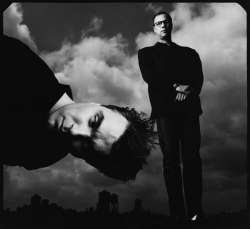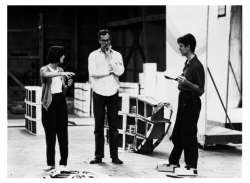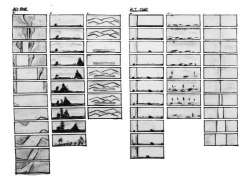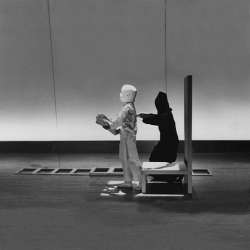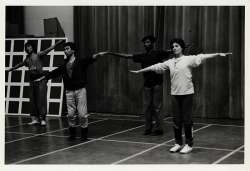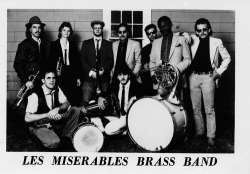It’s not as odd a thing as one might think. In the theater they are the “joints” that hold together the larger scenes—even Shakespeare used them. All those short comic scenes with buffoons or side characters who would sometimes comment on the larger action functioned as knee plays. Those typically small scenes would usually happen in front of the drop curtain and wouldn’t require large sets or crowds, so they allowed the main actors to change costumes or the crew to make scenic changes. Other forms of theater use similar devices. They are often called entr’actes.
In 1983, I was approached by theater director Robert Wilson to collaborate with him on his production the CIVIL warS. I’d seen some of his work around town in the years prior to this—Einstein on the Beach (1976) and A Letter for Queen Victoria: An Opera (1974), for example—and I was knocked out by what he was doing. I think he knew me by reputation as a pop musician, though I doubt he listened to pop music, and I suspect he knew that I’d collaborated with Twyla Tharp on an evening-length dance piece called The Catherine Wheel(1981).
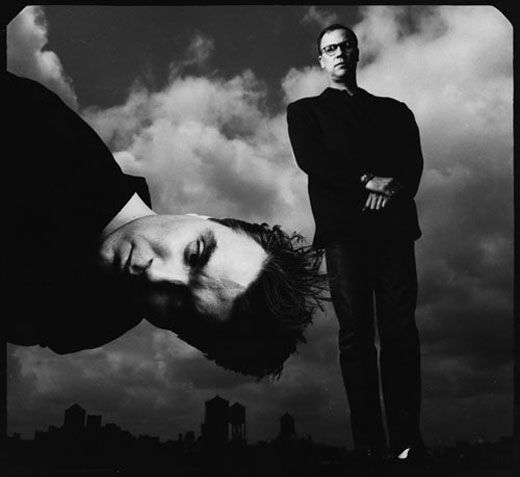
Bob and I met, and he explained the CIVIL warS as only he can. He has a mesmerizing voice and presence, and though he dresses conservatively for a downtown avant-gardian his Waspy attire somehow allows him to get away with proposing the most outrageous productions—and this was no exception. Bob had his pitch down on the CIVIL warS project, and, as is his wont, he explained the project mainly through a series of drawings and diagrams that he continually produced as he talked.
Bob has some great aphorisms. One goes something like, “I can’t explain what my work is about, but I can describe how I make it.” Which is true—he begins with structure, not narrative. Sometimes he’ll propose that a piece have five large acts, for example. Then he might say that the acts at the beginning and the end will be mirror images of each other, and the one in the middle will be the “axis.” He might set lengths for each act or scene, and these timings will be completely arbitrary, as there is no “content” for these scenes yet; but he will (sometimes) nonetheless adhere to that structure.
Defining the structure in this way automatically restricts what the content can be, what is possible—and things start to fall into place. Not into a place that a conventional Broadway or West End theatergoer would recognize, but a place that might not be unfamiliar to a Kabuki audience—though the look and style are purely Western.
the CIVIL warS, in a nutshell, was to be a massive production presented at the 1984 Olympic Arts Festival for the XXIII Sports Olympiad in Los Angeles. An auspicious year, eh? Each massive act, each one a theater production in itself, was to be created in a separate country, and then the parts and sets would be shipped to L.A. and the whole thing presented as one long piece at the Shrine Auditorium. The whole shebang would run, well, at least 10 hours—not an extraordinary length for a Bob piece. There were hosts of collaborators (Philip Glass was writing music for at least two acts, I believe) and international actors of all types. (While I was involved he tried to get Kabuki star Tamasaburo Bando and David Bowie to act in parts of the CIVIL warS.)

Having seen previously how expensive and unwieldy Bob’s pieces could be—well, for usually underfunded avant-garde theater—and therefore how seldom seen many of the pieces were, I suggested that I might collaborate on the joints, the Knee Plays. I imagined these would be a lighter and cheaper production, which might therefore possibly tour beyond L.A. or wherever it was created. (This proved to be true.) I knew that collaborating on the smaller production would probably sacrifice some “wow” factor that the larger acts would possess, but, I reasoned, what good is a spectacle if no one sees it?
Bob actually had a kind of “story” for the Knee Plays, which is highly unusual for him (he usually works in images, or by deconstructing a classic until the story is all but invisible). His story was like a folktale or a myth, but with some historical events mixed in, such as Admiral Perry and the Japanese encountering one another. It follows a group of people as they make a boat out of tree and travel to strange and foreign lands and…? How this story would be imparted—visually, musically, or via text—was not specified. Answers to those questions would, presumably, emerge in the collaboration. Bob and his producers said it could be workshopped in Japan, alongside one of the larger acts.
I love Japan, and Japanese culture, and my girlfriend at the time, Adelle Lutz—later my wife—was fluent in Japanese and was already working with Bob on the Japan Section of the CIVIL WarS, so it all sounded like a great opportunity and a wild adventure. Adelle, being well-versed in Japanese theater and Peking Opera, thought these might be interesting choices to inform the Knee Plays. We went to a lot of traditional Japanese theater and dance: Kabuki, Bunraku, Noh, and some of the wackier traditional comedy-dance shows. It was all hugely exciting and influential, both on the Knee Plays and on my own work later on.

We all assembled in Tokyo and the workshops took place at an industrial warehouse near the bay. There was nothing out there except a few vending machines selling soymilk and large-size beers. As in a lot of cities, the waterfront had been appropriated by industry and then abandoned, leaving industrial spaces with extraordinary views.
Knowing that in the final production there might be some noisy scene- changing going on during these short plays, I reasoned that the music I created would need to drown out those noises. The music or musicians would also have to be portable—the nature of entr’actes is that they’re usually performed in front of the main curtain—so all our stuff would have to enter and exit swiftly and couldn’t be preset. So, at that time, I tried using percussion instruments—as used in Kabuki and elsewhere—as sound effects and as commentary on the action rather than as “music.” I worked with some traditional Kabuki musicians in a recording studio, and “directed” them by describing imaginary scenes. This was what they were used to as far as musical direction; they didn’t play “music” as we know it in the West, or grooves (although there were occasional dance numbers). I had a few of these same instruments that I could play during rehearsals in the Tokyo warehouse, to see how the sounds complemented the action. It worked OK, but I wasn’t sure.
For me, this was a different definition of music. As I said, the traditional Kabuki form of music doesn’t rely on written melodies, and is perhaps more akin to the work of a foley artist in film post-production, or the sound designer in films such as Hitchcock’s, or the work of Walter Murch on THX 1138 (1971), or the work of contemporary composers using indeterminate scores.
Meanwhile, rehearsals for the other, larger act continued parallel to ours. Bob had enlisted a local Butoh group, who practiced a genre of Japanese avant-garde theater based, sometimes, on traditional movements or attitudes, but updated. They appeared with their genitals squished into swim masks and covered with white powder, which they seemed to manage to spread everywhere.
Adelle suggested adapting the concept used in Bunraku (Japanese puppet theater) whereby the musicians and the storyteller would be present on the stage alongside the actors/dancers. We set ourselves to the problem of how, for starters, to make a tree into a boat on stage as described in Bob’s story. I came up with a not-entirely-original solution. If everything were made of a grid of cubes, with all the shapes abstracted into cube modules, then, like big children’s building blocks (or a Sol Lewitt sculpture in this case), things could be “transformed” by the actors into various objects: trees, boats, or maybe even a bird. (Well, maybe not this last one). Adelle, inspired by Peking Opera, suggested creating the sea by using fabric on poles. Almost all the props could therefore stay flat and portable.
After some sketching it seemed like a promising approach, so we got some cardboard boxes and made rudimentary cubes and began to figure out how this story might be told. It turned out it could be done more as a dance than a naturalistic drama, which suited Bob’s own style perfectly. The performers would use these light hollow cubes as props that would become rudimentary sets.
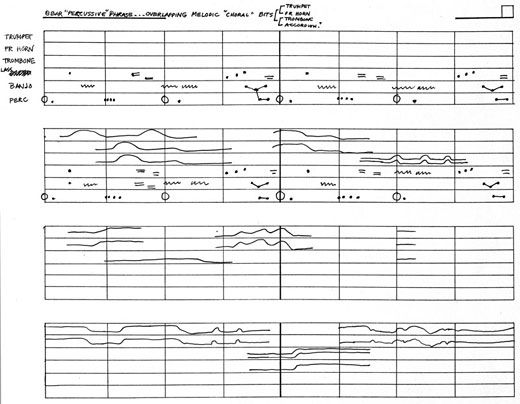
Upon returning to New York City, Adelle and I began to research some of the less classic dance styles we’d seen in Japan, as those seemed absolutely to echo the work of the downtown NY crowd. Robyn Brentano at Bob’s office introduced us to Beate Gordon at the Asia Society, and she introduced us to Suzushi Hanayagi, a traditionally trained Japanese dancer who had also worked with Trisha Brown and others at the Judson Church, an early home for some dance and performance art. Beate was adamant that Suzushi would not be offended by what we were doing with Kabuki dance. So, comfortable in both worlds, Suzushi was a perfect fit! It was decided that she would choreograph the Knee Plays when the production went into the next phase of rehearsals in Minneapolis.
Meanwhile, I had decided that the Kabuki percussion idea wasn’t so perfect after all. I remembered hearing the Dirty Dozen Brass Band at a place called The Glass House in New Orleans a while back, and I thought they would certainly be loud enough to drown out backstage noise, and their funky riffing and incredible feel would be an unexpected yet mesmerizing juxtaposition to Bob’s usually cool stage pictures. They’re no strangers to repetition, which might complement the incremental changes in Bob’s staging, but they’re also funky as hell, which would be a bit of a wild card. So I contacted them, and before going to New Orleans I wrote a bunch of pieces and had some traditional gospel and folk tunes scored for them. I had a great time in New Orleans—it’s hard not to—but musically it was not happening. Despite being great musicians and playing a wide variety of material, from Monk to Second Line to TV themes like “Wild Wild West!” being strapped into the scores was not a comfortable or creative place for them. I moved on and hired local musicians in Minneapolis for that stage of the piece.
Auditions for the performers were set up in New York. They were a motley bunch: some had worked with Bob before, while others had backgrounds in dance or downtown theater. There was a variety of body types and sizes too, a welcome change for a “dance” production. In fact, anyone who was “balletic” or “dancerly” was immediately disqualified.
The Rome Section opening of the CIVIL warS was delayed due to strikes and as a result Bob could not be in Minneapolis in time for the initial rehearsals. Suzushi and Adelle ran the workshop in his absence, during which the dancers simply studied Kabuki dance exercises over and over, honing their movements and becoming a unit. The performers had nothing but admiration for soft-spoken Suzushi—maybe twice the age of many, she had more stamina and endurance than any of them.
I arrived and we began to sketch out on stage how each of Bob’s narrative instructions could be realized. In Einstein on the Beacheveryone wore thrift store outfits, suspenders, and sneakers, so I assumed low budget costumes might be OK for this production too, but maybe not for the large acts. We ordered a bunch of lab coats from a scientific catalogue, which complemented the white cubes and the minimal staging pretty well—dancing scientists, sort of. Bob arrived and he began to think about lighting—his lighting is amazing. In this case he hid strips of neon on dimmers behind a small barrier upstage. It created a very even and unearthly glow on the upstage scrim.
Bob also added white face paint to the dancers with bright red mouths— Kabuki? Chaplin? Vaudeville? Weimar Cabaret? The movements in the exercises were so stunning and modern looking that Bob used many of them in mini-Knee plays linking together the main Knee plays. Suzushi joined the production as a performer, and Knee Play 10, “Winter,” was essentially a solo for her. She transposed elements of a traditional dance into a completely nontraditional context and the result was something deeply sad, strange, moving, and arresting.
Again inspired by Einstein and other productions of Bob’s I’d seen, I began to write text pieces that could be recited over the pieces I’d written for a brass band. None of these was directly related to Bob’s “story” and they were certainly unrelated to the stage action. But I realized that things that happen simultaneously are often presumed by the mind and heart to be related in some way. This serendipitous chance structure may have come from a line stretching back to the Surrealists or the Dada poets, or from Cage and Cunningham (very likely the latter, in Bob’s case). Their argument was often that nature, life, the world, all work this way—wildly disparate things happen simultaneously and we presume that connections exist. Intentionality is merely a concept we construct. Therefore, to “illustrate” things that are happening on stage with music or text is redundant. When you look up at clouds in the city, and the sound you hear is hip hop and traffic noises, well, that’s the score for the cloud image—you just accept it. So why not accept similar connections on stage? When it worked it added a resonance and a crazy wider meaning to the whole thing. When it didn’t work it just seemed like nutty artsy-fartsy stuff.
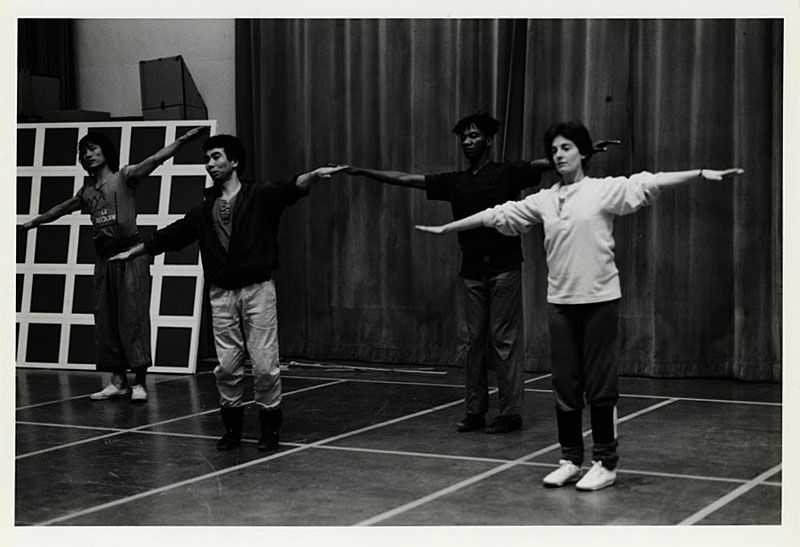
Some of these texts were goofy but plausible little stories, some were lists, and some were instructions. I’d remembered JG Ballard saying once that lists, ads, codes, and instruction manuals are the invisible literature of today. I became the de facto reader of these texts in the initial performances, although Matthew Buckingham, now a well-respected artist and filmmaker, took my place when the piece toured.
Later, I recorded the pieces in L.A., with some of the best R&B and session musicians around, thanks to Gary Goetzman and some others who helped with the contracting and coördinating. The sessions were pretty exciting, though even these musicians had some problems with the syncopations for “In the Future.” Later, when the piece toured—as I’d hoped it would—the existing brass band Les Misérables (led by Frank London) took over and made it their own.
But what happened to the CIVIL warS? Oh, that. That’s a book unto itself. The Japan Section got only as far as the middle of one invited rehearsal when the “curtain came down.” The Butoh dancers, almost naked and cross-eyed, contrary to stage directions, started flapping their white makeup all over the Noh dancers’ lion wigs and extremely pricey brocade costumes. The Butoh leader started screaming in English, “We need light. We have Tofu face!” That production was never seen again.
According to some, L.A. pulled its funding at the last minute, funding which was to cover not the creation of the sections but the shipping of the sets and paraphernalia to L.A. and the restaging at the Shrine. I, for one, was not surprised. Things may have changed by now, but back then L.A. had a weak philanthropic arts community for contemporary work, and the public there was also not accustomed to productions like this. That said, I saw some large-scale international acts as part of the Olympic Arts Festival, so some groups were getting support. It was all a big scandal and Bob was heartbroken even if doing something of that scale in L.A. at that time did seem like a kind of quixotic quest. However, I remembered that he and Philip Glass had done Einstein at the Met, despite a lot of naysayers, so you never know. I think they had to rent that hall themselves.
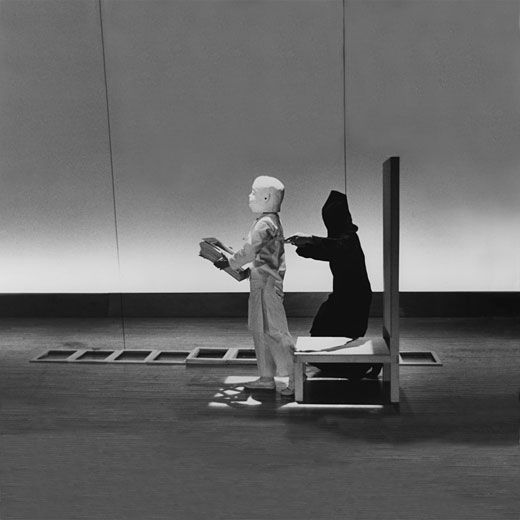
This recording of the Knee Plays originally came out through ECM, the label known for innovative jazz and contemporary classical music with a lot of reverb. ECM recordings were being distributed by Warner at the time, which also distributed Talking Heads, and I thought the ECM audience and marketing sense might fit this project. I like a lot of what they do, so the original LP sleeve was designed to look like an ECM record. In retrospect, this wasn’t the smartest idea I’ve ever had.
It’s wonderful to see this project available again. I performed this material not so long ago at a Katrina benefit, and at Zankel Hall with Frank London and his current crew—and I don’t know about me, but they’re better than ever.
DB
NYC 2007
